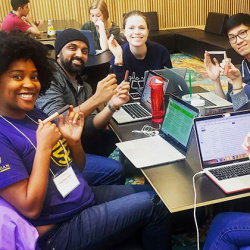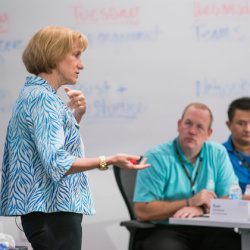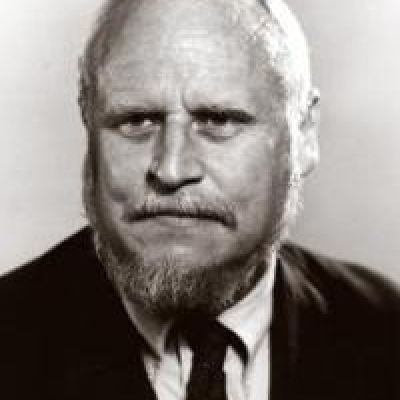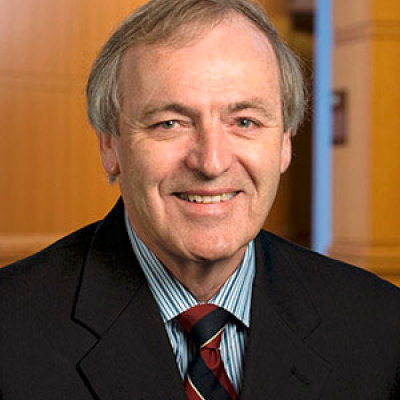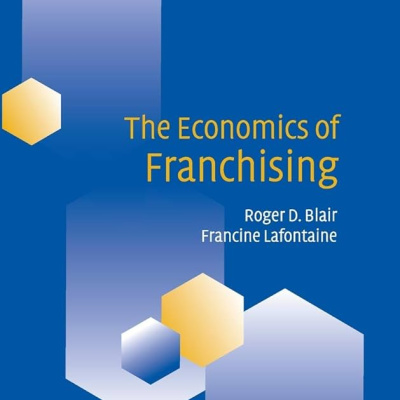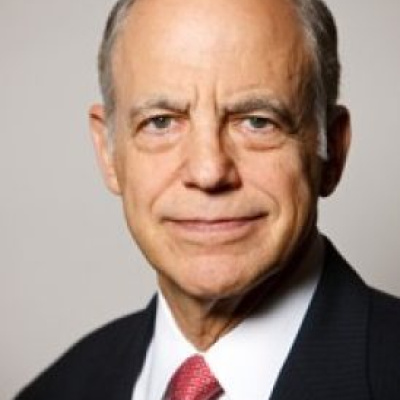Explore the faculty research, thought leadership, and groundbreaking philosophies that established Michigan Ross as one of the world’s top business schools.

Michigan Ross has long been a pioneer in entrepreneurial education, introducing the nation's first course on entrepreneurship in 1927. However, in the early 1970s, Professor LaRue Hosmer played a pivotal role in championing entrepreneurship education at Ross. He developed and taught courses in small business management and a seminar on small business formation. He is considered the founder of the Michigan Entrepreneur Track and has also inspired present-day entrepreneurship faculty at Michigan Ross, including Professor Andy Lawlor. Lawlor was a student in Hosmer's entrepreneurial management course in 1973, and Hosmer has been an important mentor to Lawlor, helping to bridge the gap between business and teaching. Lawlor began guest lecturing under Hosmer's guidance in 1975 and assumed the teaching responsibilities for the entrepreneurship classes in 1981. Over the years, many successful companies have been born from Hosmer and Lawlor's teaching.

The Personal Development Plan is a simple but impactful idea that has now been utilized by approximately 6,000 BBA alums and current students. At its core, the PDP is an Excel document that helps students plan the requirements to graduate, but its usage and value go far beyond just a requirement planning tool. In 2006, the BBA degree, which had for decades been a two-year degree program, was modified to a three-year structure with a small number of first-year preferred admits. Eight years later, in 2014, the BBA curriculum was modified from a 45 business credit requirement to 58 business credits. The changes to the curriculum meant that students had significantly more time, more flexibility, and more choices in how they progressed through the BBA degree. That flexibility increased even more as we moved to a four-year program in 2017. Advisors developed the PDP as a resource to help students make the most out of this expanded college experience.
In 2014, with the launch of the 58-credit BBA curriculum, a new core course was created, BA 200. As part of BA 200, PDP was introduced as a required component of the class and is now a co-curricular component of BA 100 and BA 102. Each year, the undergraduate advising team works with over 625 new BBA students (first-year students and transfers) so that each student develops an individualized plan for their life as a college student. Ensuring that they are planning requirements is an important part of this, but in developing their plan, students are asked to reflect on their goals for their time in college while developing their PDP. What skills and competencies do they hope to develop while they are here? Are there opportunities they want to take advantage of (study abroad, participation in programs through centers and institutes, minors or dual degrees, club leadership, etc.)? The PDP is a living document that travels with students throughout their four years and becomes a reference point for continued conversations and relationship-building with advisors until graduation. The PDP has had an impact on every single BBA student since the fall of 2014, helping to open their eyes to the rich opportunities at Michigan Ross and giving them a roadmap to their unique journey as a Ross BBA.

Expanding on his dissertation thesis, completed in 2003, Professor Paolo Pasquariello's powerful insight (published in 2007) demonstrates that financial contagion (the spread of a shock from one financial market to many) could occur due to the simple, and highly plausible, heterogeneous private information of speculators about fundamentals. Financial contagion is an increasingly common phenomenon of global concern, especially during financial crises. Importantly, Pasquariello's theoretical multi-market setting rules out all the more complicated explanations of contagion --- usual suspects such as correlated information and/or liquidity and portfolio rebalancing --- while linking it to some of the main features of globalization, the expansion of and access to international financial markets.

Professor David Brophy brought the study of small businesses and private financial markets (now known as alternative, in contrast to publicly traded markets) to Michigan Ross and the state of Michigan before it was recognized as a legitimate area of study at top research universities. This process started in the mid-to-late seventies, and Brophy relentlessly created awareness in Michigan and educated students interested in this space. For over fifty decades, until his recent retirement, Brophy designed and taught all Michigan Ross venture capital and private equity courses.

Originally launched by Michigan Ross Professor David Brophy and now organized and run by the Zell Lurie Institute for Entrepreneurial Studies, the Midwest Growth Capital Symposium began as an opportunity to showcase innovative Michigan ventures seeking funding and connect them with venture capitalists, angel investors, industry stakeholders, and leaders from across the nation.
Today, the Symposium provides a platform for pre-selected Midwest companies to present their business ideas and investment opportunities. These companies span various sectors, such as life sciences, healthcare, technology, food and agriculture, and energy. First held in 1980, the Symposium is the longest-running university-based venture fair of its kind, has gained recognition, and attracts attendees from across the country.
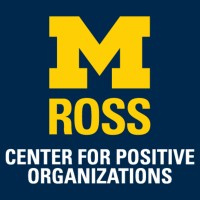
The late 1990s ushered in a revolutionary view across the social sciences centered around the power and importance of studying strengths, better understanding how people thrive, and how systems seize opportunities for creating excellence. Michigan Ross led the way in advancing this fundamental research shift in the field of management and organizations, with many scholars publishing seminal research in the field. In 2002, three faculty members, Jane Dutton, Bob Quinn, and Kim Cameron, founded the Center for Positive Organizations to encourage rigor in this growing field of research and to serve as a home for a large network of scholars interested in pursuing this line of inquiry. As the field has grown over the years, Positive Organizational Scholarship has influenced how management is taught and practiced. CPO at Michigan Ross is a leader in helping teachers and students tap into this body of evidence and learn about this research through innovative courses and developmental learning programs. Those tools include the "Reciprocity Ring", a dynamic group exercise that applies the “pay-it-forward” principle while creating high-quality connections, and the "Reflected Best Self Exercise", which helps you see who you are at your best to engage you to live and work from that powerful place daily.
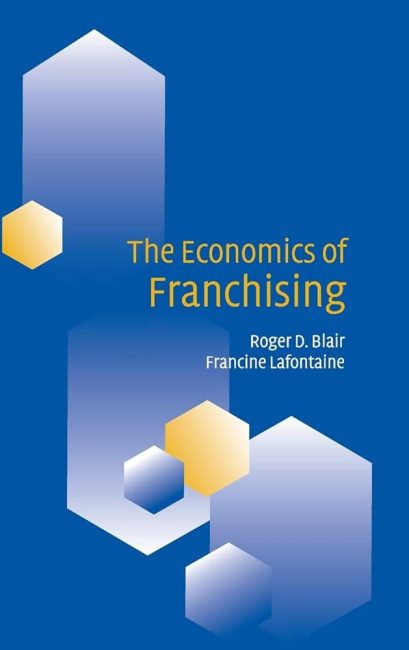
Franchised chains have an outsize influence on the economy: firms involved in a variety of business activities are organized as franchised chains and they employed over 9.6 million workers in the United States in 2017 according to the Census Bureau. Professor Francine Lafontaine's pioneering work on franchising shows that the success of this organizational form across various sectors results from the franchisor and franchisee specializing in the activities they are best suited to. Specifically, the franchisor specializes in creating and supporting the business format and brand, where scale is especially beneficial, and the franchisee optimizes operations locally, where their knowledge and efforts are particularly valuable. Lafontaine's work in this area has informed the choices that franchisors make and the nature of the contracts they use, and also the debate over legislation that aims to address the alleged shortcomings of the franchising organizational form.
Her work suggests caution in developing potential public policy changes as consumers, existing and potential franchisees, as well as their employees stand to lose in the long term if franchising becomes less competitive as a form of organization. More broadly, Lafontaine's research has made seminal contributions to our understanding of how firms interact with each other in the process of procuring inputs or distributing their products, and prompted her appointment as Director of the Bureau of Economics at the FTC in 2014-15. In particular, her research has shown that factors driving vertical integration and vertical contracting can be very different from those motivating horizontal mergers, so analyses of vertical mergers should start from a different premise compared to analyses of horizontal mergers. Her detailed analyses of franchise contract terms, as described in her book The Economics of Franchising, provide further reasons why, in her view, the rule of reason continues to be the right approach in antitrust cases involving vertical restraints.

The paper "Quantity Flexibility Contracts and Supply Chain Performance" by Professor Bill Lovejoy and his colleague, Andy Tsay from Santa Clara University, was published in Manufacturing & Service Operations Management in 1999. The paper delves into the concept of quantity flexibility in supply chain contracts and its potential to deal with demand uncertainties. This influential work formally captured the practice of “funneling” variability over time, whereby more variability is tolerated in earlier planning phases and less tolerated over time as the delivery date approaches. This paper has specifically led to further studies on the optimal design and effectiveness of supply chain contracts, enhancing the field’s understanding of tactical and strategic issues in supply chain management. Researchers have built on Tsay and Lovejoy's model to study the application of QF contracts in different industrial contexts and their interactions with various supply chain configurations. The concept and modeling presented in this paper have become a prominent part of the academic discourse on supply chain coordination, influencing subsequent studies in inventory management, order variability, and supply chain profitability. Thus, the paper's impact is significant and broad, inspiring much-needed research on flexible, cooperative strategies for supply chain optimization.

Professor Kenneth Lieberthal was a pioneer in the practice of business school professors contributing their knowledge in public service to society. Lieberthal served as the senior director for Asia for the U.S. National Security Council during the years 1998-2000.
During that same time, Lieberthal was also special assistant to President Clinton for National Security Affairs. His core academic research findings included a seminal analysis of China's bureaucratic system, which featured a nuanced and careful delineation of the fragmented nature of China's political system in the late 20th century.
Lieberthal's research was able to explain why China, during that era, had weak policy implementation at times because of the fragmentation in its bureaucratic system. He was known for introducing U.S. policymakers to a nuanced and careful understanding of the Chinese governmental system and how it functions.

No matter the discipline, business research can have a huge impact on diversity, equity, and inclusion. In 2013, Venky Nagar, KPMG Professor of Accounting, along with former Michigan Ross professor Feng Li, published accounting research on U.S. firms initiating same-sex domestic partnership benefit policies.
Li and Nagar’s paper “Diversity and Performance,” published in Management Science, tests if corporate policy supporting LGBTQ+ rights frees all employees to bring their authentic selves to work, thus improving org culture and performance. The paper finds that the nearly 300 firms that adopted these policies between 1990 and 2006 saw significant improvement in operating performance relative to an approximate 10% average stock price increase. If an investor had accordingly timed their purchases of these firms, they would have outperformed ninety-five percent of all U.S. professional mutual funds.
The paper’s reasoning was core to the 2015 Amicus Brief filed in support of legalizing same-sex marriage by the law firm Morgan Lewis on behalf of 379 large and small corporate employers ranging from Apple to Zingerman’s in the landmark Supreme Court case Obergefell v. Hodges.

The Integrated Product Development course is a unique cross-disciplinary experiential course delivered jointly by Michigan Ross, the College of Engineering, and the Stamps School of Art and Design. The course requires teams of business, engineering, and art students to execute the full range of the product development and launch process, from early-stage ideation through design and fabrication to launch stage promotion, pricing, and inventory decisions.
It has been continuously offered for more than 30 years and has been featured on CNN and in BusinessWeek, the New York Times, and the Wall Street Journal. Professor William Lovejoy originally designed this course, but it was subsequently taught by a series of dedicated professors drawn from the three units. It remains a course students remember and refer back to throughout their professional careers.

Since the COVID-19 pandemic, the public K-12 education system has faced significantly high teacher turnover and poor retention rates. Teachers have faced increasing pressure to achieve academic success while challenged with growing class sizes, reduced funding, and learning loss from the pandemic. This problem has been incredibly difficult to correct, and public school districts across the country have not been able to address it cost effectively.
In their paper, “Stopping the Revolving Door: An Empirical and Textual Study of Crowdfunding and Teacher Turnover,” Professors Samantha Keppler, Jun Li, and Andrew Wu conducted a study of data from the largest teacher crowdfunding site, DonorsChoose, to study the effect of crowdfunded projects on teacher retention. The team found that teachers are less likely to leave their schools and the state public school system when their projects are funded. Assessing teachers’ project request essays, they identified that teachers who received funding for unique projects or requested resources to improve their classroom environment had higher retention rates.
Their paper is the first to identify the effect of crowdfunding on teacher retention. It provides initial, strong evidence that the effect is positive, showing that teachers funded on DonorsChoose are 1.6 percentage points (pp) less likely to leave their schools and 1.9 pp less likely to leave the teaching profession — a 14% and 41% reduction versus baseline turnover and attrition rates, respectively.
Due to the demonstrated impact of teacher-driven crowdfunded projects, DonorsChoose has partnered with eight states to spend COVID-19 education relief funding on teacher crowdfunding projects. To date, these partnerships have funded over $100 million of teacher projects from over 100,000 teachers, impacting over 10 million students.

The public corporation in America is vanishing, and more people, from low-income earners to professionals, are doing their work in the so-called “gig economy.” The work of Professors Jerry Davis and Sue Ashford put these two issues on the research agenda of scholarly colleagues. Davis documents the first idea in his book, The Vanishing American Corporation (2016). Although some scholars have suggested that over-regulation might account for this surprising trend, he argues that a more fundamental shift in the economy, enabled by information and communication technologies, was ultimately responsible. By making it cheaper to "buy" rather than "make" inputs (from capital and labor to supplies, manufacturing, and distribution), information and communication technologies have made the parts of an enterprise like a pile of Legos, ready to assemble into a business, scale, and disassemble. This idea explains Nikefication, Uberization, Amazon, and other recent trends in the organization of the U.S. economy, as well as why the same technologies are used differently in different countries, resulting in very different corporate structures. If what Davis says is true, then fewer people will be working in large public corporation settings going forward. This shift may account for the growth in people working independently, some using technologically mediated apps to find and conduct work. Ashford puts the gig economy and gig workers on the agenda of people wanting to understand individuals at work. Her qualitative and quantitative studies identify the challenges faced by those working independently and what they can do to survive and thrive. Challenges include maintaining one’s identity, keeping sufficient income flowing in, staying organized, finding and maintaining work connections, and figuring out how to make working in this manner work over the long run. This research tests a variety of interventions and solicits ideas from individuals working in this manner regarding strategies that make this kind of work-life viable and enlivening.

